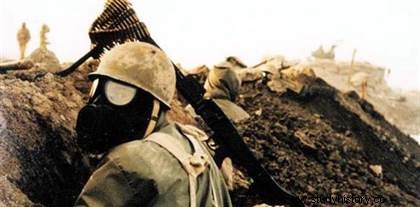 The Iran-Iraq War is an armed conflict between Iran and Iraq between 1980 and 1988, with the main issue being supremacy in the Persian Gulf. By triggering hostilities on September 22, 1980, Saddam Hussein had banked on a dazzling offensive and a short war that would make his country the leading power in the Middle East. This ambition will not withstand the harsh reality of a fierce conflict, one of the most devastating of the 20th century, which will only end eight years later. Peace between Iran and Iraq was signed on August 20, 1990 on the basis of the statu quo ante bellum . The two countries come out bloodless from this war which left 1,200,000 dead.
The Iran-Iraq War is an armed conflict between Iran and Iraq between 1980 and 1988, with the main issue being supremacy in the Persian Gulf. By triggering hostilities on September 22, 1980, Saddam Hussein had banked on a dazzling offensive and a short war that would make his country the leading power in the Middle East. This ambition will not withstand the harsh reality of a fierce conflict, one of the most devastating of the 20th century, which will only end eight years later. Peace between Iran and Iraq was signed on August 20, 1990 on the basis of the statu quo ante bellum . The two countries come out bloodless from this war which left 1,200,000 dead.
Origins of the Iran-Iraq War
The Iranian Islamic Revolution of 1979 upset the balance of power between the powers of the Middle East. Iran hitherto the centerpiece of the device of 'containmen The American set himself up as a troublemaker, resolutely opposed to the influence of Washington, without getting closer to Moscow. For Saddam Hussein, who had recently mastered Iraq, there was as much threat there as tempting opportunities.
Iran Khomeinist through its revolutionary rhetoric and its influence within the Iraqi Shiite communities (in the demographic majority, but excluded from power since the creation of Iraq), represented an immediate danger for the Baathist regime. Nevertheless, its isolation on the international scene and the supposed weakness of its new institutions made it a tempting target.

The old Iranian-Iraqi dispute could provide a convenient casus belli in this regard. The two states had long vied for the status of dominant power in the region (which had earned Khomeini to be supported by Baghdad when he was only an opponent…). At the heart of their rivalry the border region of Khuzestan , possessed by Iran but populated by Arabs and which Iraq claimed as its own. A region rich in hydrocarbon deposits, which also gave its owner great latitude to control the waters of the Persian Gulf.
In the course of 1980, Saddam Hussein made the decision to attack Iran militarily. He hopes there to bring down a potentially dangerous regime, which will allow him to present himself as a protector of the Gulf monarchies (targets of Iranian activism, in particular because of the treatment they reserve for their Shiite communities and their alignment with Washington) and to satisfy its territorial ambitions. Undoubtedly, such a victory would make Iraq the leader of an Arab world, very divided since the Yom Kippur War (if not before).
The march to war was swift and masterfully organized by the Iraqi dictator. After having, through intensive propaganda, underlined the danger posed by the Khomeini regime for the region (helped in this by hostile declarations from Tehran), Saddam Hussein accused Iran of having organized an attack against his Deputy Prime Minister. Once diplomatic relations were severed, the Iraqi president denounced the Algiers agreements of 1975 supposed to settle border disagreements with Iran. 5 days later, on September 22, the Iraqi armed forces launched their major offensive.
After several days of open tension, the Iraqi air force engages in a large-scale offensive against Iranian targets. Tehran's air force is targeted, as well as the oil fields of Abadan. The following day, six Iraqi divisions launched an assault on Iranian territory.
Khomeini Iran put to the test by war
In many ways, the Islamic Republic of Iran of September 1980 seems fragile. Resulting from a revolution animated by very diverse movements (from modernizing liberals to communists), it only saw Khomeini's supporters win after a deaf and violent struggle. Some parts of the country (Baluchistan, but especially Khuzestan) are experiencing armed rebellions against the regime. Economically, the country is still suffering the aftermath of the previous two years of turmoil, as well as the end of American financial support.
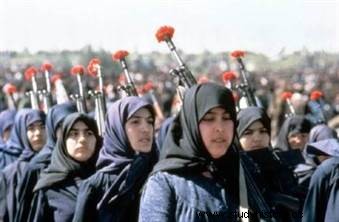 Equally serious, the Iranian armed forces are in a worrying state. From the management point of view, they bore the brunt of the purges carried out against officers suspected of being hostile to the new regime. The creation of the Revolutionary Guards (Pasdarans), the praetorian guard of the regime, further weakens the coherence of the whole. If on the material level, the initial situation is far from being hopeless (the Iranian army being largely equipped with modern weapons systems), Tehran cannot envisage a conflict which would continue with serenity. Deprived of heavy armaments industry, the Iranians are dependent for their armor and their aviation on foreign parts (often American), which they will have difficulty obtaining.
Equally serious, the Iranian armed forces are in a worrying state. From the management point of view, they bore the brunt of the purges carried out against officers suspected of being hostile to the new regime. The creation of the Revolutionary Guards (Pasdarans), the praetorian guard of the regime, further weakens the coherence of the whole. If on the material level, the initial situation is far from being hopeless (the Iranian army being largely equipped with modern weapons systems), Tehran cannot envisage a conflict which would continue with serenity. Deprived of heavy armaments industry, the Iranians are dependent for their armor and their aviation on foreign parts (often American), which they will have difficulty obtaining.
Finally, for their initial offensive (named Qadisiyya in reference to the Arab invasion of Persia in the 7 th century) the Iraqis enjoy a great superiority in means due to a greater concentration of their forces; this, in the face of an Iranian army compelled to secure other hot spots (borders with the USSR and Pakistan in particular). The Iraqi plan is based on a main offensive in the south in Khuzestan (with 4 divisions), while two other divisions attack further north to guard against an Iranian counterattack. Baghdad assumes that once Khuzestan is occupied, the mullahs' regime will fall in favor of a government ready to give in to its demands.
The hoped-for collapse will never happen. First, the Iranian air force was not destroyed on the ground after the September 22 bombings. It will keep for a time offensive capacities which will hinder the progress of the Iraqis. On the other hand, despite the lack of coordination of the Iranian defense (due to the rivalries between pasdarans and regular units) it is relentless. Still divided in relation to the Islamic regime, the Iranian population unites behind Khomeini to defend the motherland. Volunteers flock to the flags (whether of Arab, Persian or other ethnicity) and respecting a certain Shiite tradition, do not shy away from martyrdom.
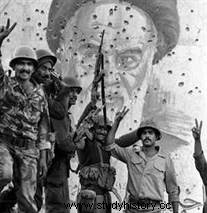 Iran's will to resist has been signaled to international opinion after Tehran refused an offer of ceasefire UN fire (September 28, 1980). The fighting in Khuzestan then became fierce, and the IRGC quickly acquired a reputation for ferocity with their Iraqi enemies. In early 1981, Saddam Hussein put an end to offensive operations thinking that time was on his side. Tehran's resistance has indeed had an exorbitant cost in terms of human and material losses.
Iran's will to resist has been signaled to international opinion after Tehran refused an offer of ceasefire UN fire (September 28, 1980). The fighting in Khuzestan then became fierce, and the IRGC quickly acquired a reputation for ferocity with their Iraqi enemies. In early 1981, Saddam Hussein put an end to offensive operations thinking that time was on his side. Tehran's resistance has indeed had an exorbitant cost in terms of human and material losses.
However, the Islamic Republic is still ready for new sacrifices, since it takes the initiative of a large armored counter-offensive in January 81. It will however be contained by a Iraqi army, better commanded and more capable of mechanized operations. Following this failure, the front got bogged down in trench fighting which was reminiscent of that of the 1st World War. At sea, the marines of both sides, after an indecisive battle off Umm Qasr , are content with limited harassment.
Standing down and international interference
The year 1982 saw the Iranian armed forces break the immobility of the front for a time. In March 1982, they attacked the Iraqi units occupying Khuzestan. Three skilfully coordinated operations allow the Iranians to liberate the province. The Battle of Khorramshahr, which will cost the Iraqis nearly 25,000 men (including 7,000 killed), is a good illustration of the revival of Iranian units which compensate for their material inferiority and inexperience with unfailing ardor in combat.
In early summer, Iraqi forces retreat to the international border and establish strong defensive positions. Iranian attacks will come to a halt there, despite the reinforcement of very young volunteer militiamen, who do not hesitate to embark on suicidal charges. Two armies of nearly 50 divisions each face each other, demanding great sacrifices from their respective countries to remain operational.
This is where the issue of international support is crucial. It is in fact unthinkable for Baghdad or Tehran to fuel such war machines alone, whether because of financial difficulties (the two countries depend on their hydrocarbon exports made difficult by the fighting) or the weakness of their arms industries. Saddam Hussein's Iraq, which from the outset presented the conflict as a defense of the Arab world against the "Persian" revolution, is supported not only by the petro-monarchies, but also by the Western camp. The United States, Great Britain, France, Italy provide Saddam Hussein with the means to constantly renew his arsenal.
As for Iran, initially isolated, it ended up finding a few suppliers, be it China, North Korea or Libya. Tehran even manages to procure crucial armaments from the United States, after skillful manipulation involving Hezbollah and Israel (which prefers Saddam Hussein to be occupied against Iran). The case will come to light in 1986 in the United States, it is the famous "Irangate and will tarnish the 2 th tenure of Ronald Reagan.
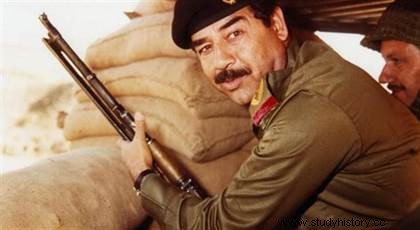 Fueled by the world's leading arms suppliers, the conflict turned into a veritable all-out war. In addition to the ideological mobilization of the population (especially in Iran, where a generation is sacrificed to the fire to compensate for the material imbalance), the belligerents will stop at nothing to obtain victory. The main cities are regularly bombarded and on the Iraqi side we do not hesitate to use chemical weapons to break the enemy momentum. Finally, from 1984 Iran and Iraq waged a veritable war on oil transport in the Persian Gulf, which did not exclude neutral vessels. This Tanker War , will also provide a pretext for Washington to strengthen its aid to Iraq and toughen its sanctions against the Islamic Republic.
Fueled by the world's leading arms suppliers, the conflict turned into a veritable all-out war. In addition to the ideological mobilization of the population (especially in Iran, where a generation is sacrificed to the fire to compensate for the material imbalance), the belligerents will stop at nothing to obtain victory. The main cities are regularly bombarded and on the Iraqi side we do not hesitate to use chemical weapons to break the enemy momentum. Finally, from 1984 Iran and Iraq waged a veritable war on oil transport in the Persian Gulf, which did not exclude neutral vessels. This Tanker War , will also provide a pretext for Washington to strengthen its aid to Iraq and toughen its sanctions against the Islamic Republic.
Despite this escalation in terror, no side seemed able to prevail between 1983 and 1988. The successive Iranian offensives, which for many took place in the swamps and in direction of Basra , are contained (with difficulty) by an Iraqi army with greater firepower. The revolt of the Peshmerga Kurds in northern Iraq did not provide the expected diversion either and was finally crushed in the spring of 1988 (resulting in the chemical bombing of Halabja). However, bled by the Iranian operations of 1984 and 1987, Saddam Hussein's army lacked teeth. His last offensive in April 1988, which aimed to promote a takeover of power in Iran by the people's mujahideen (leftist Iranian rebellion) was, moreover, a failure.
Under pressure from the UN and convinced that the battlefield could no longer decide between them, the two belligerents agreed to sign a ceasefire which came into effect on the 20 August 1988 (united nations security council resolution 598).
Iran-Iraq war:a conflict for nothing?
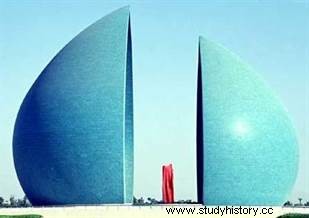 When the guns finally fall silent, Iran and Iraq find themselves equally exhausted. The combined economic losses of the two countries amount to several hundreds of billions of current dollars. The human toll is also terrifying. 300,000 dead for Iraq, maybe a million for Iran.
When the guns finally fall silent, Iran and Iraq find themselves equally exhausted. The combined economic losses of the two countries amount to several hundreds of billions of current dollars. The human toll is also terrifying. 300,000 dead for Iraq, maybe a million for Iran.
Politically, Saddam Hussein is largely losing. Not only has he failed to bend Tehran and make Iraq a Middle Eastern hegemon, but on the other hand he is now largely indebted to the oil monarchies of the Gulf. Its prestige with the population is then at its lowest. To turn the situation to his advantage, the Iraqi dictator will end up embarking on an adventure that is far too risky:the invasion of the small emirate of Kuwait (supposed to bail out the Iraqi coffers by blackmailing Riyadh).
The Iranian regime came out of the war much stronger. Not only did he gain legitimacy in the eyes of his own population (united in a great patriotic outburst and imbued with propaganda) but also with regimes and politico-military groups favorable to his theses. This will only reinforce its regional role as a disruptive power that still today continues to agitate the Near East and the Middle East.
Bibliography
- The Iran-Iraq War, by Pierre Razoux. Tempus, 2017
- Iran-Iraq:A 5000 Year War by Paul Balta. 1999.
